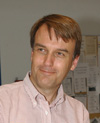| Wednesday, June 25, 2008 |
| Subscribe | Contact Fermilab Today | Archive | Classifieds |
Four yearsJim Strait, head of the Particle Physics Division, wrote this week's column.
This is my last Fermilab Today column. As many of you know, I will step down at the end of this month after almost four years as head of the Particle Physics Division. Later this summer, I will head to CERN to work on the commissioning of the LHC. While it would be crazy to say that every moment of this job was fun, it has been on the whole, a very satisfying experience. I feel honored to have had the opportunity to head this marvelous organization. The last four years have certainly had their ups and downs. But despite staff reductions in two of the last four years and the cancellation of BTeV due to budget shortfalls, the experimental program has remained very strong. CDF and DZero have produced a flood of new results, including the first observations of Bs oscillations, increasingly precise measurements of the W boson and the top quark mass, and the race to find the Higgs boson. MINOS is making the world's best measurement of neutrino oscillations. MiniBooNE has laid to rest the LSND neutrino effect observed at Los Alamos, but it has discovered an apparent anomaly in low-energy electron production. SciBooNE was proposed and built in near-record time and is nearing completion of a successful data-taking run. MIPP has completed its data-taking in the Meson building and will soon publish results on particle production that have the potential for wide impact on other experiments. CDMS has produced the world's best limits on dark matter detection. COUPP has yielded competitive results in the spin-dependent dark matter search. The Pierre Auger experiment has shed new light on the origin of the highest-energy cosmic rays. The Sloan Digital Sky Survey has greatly advanced our understanding of the structure of the universe. After more than a decade of work, the CMS detector at CERN is nearing completion. We are on the threshold of a revolution in our understanding of particle physics as CMS and the other LHC experiments will begin to deliver results at the energy frontier. Here at Fermilab, MINERvA is now under construction and will take data with the NuMI neutrino beam. NOvA is ready for construction, and we are hopeful that restored funding will allow this neutrino experiment to go forward. Project X has risen from the ashes of the Proton Driver and, if built, its high-intensity beams will allow for new experiments. At the cosmic frontier, DOE and NSF have approved the Dark Energy Survey Camera project, and we are starting to build this state-of-the-art instrument for the Blanco telescope in Chile. R&D programs have made substantial progress on new detector technologies, such as advanced pixel detectors for future lepton collider experiments or for CMS upgrades, and liquid-argon detectors for very large neutrino experiments or for dark matter detection. The upgraded Meson Test Beam Facility is in constant use by detector developers from around the world. Satisfying as all of these scientific and technical advances are, for me the best part has been the opportunity to work with PPD's incredibly talented and dedicated staff - technicians and scientists, engineers and administrators, safety professionals and designers, and all those incredibly versatile people who don't fit into a single job category. I look forward to the opportunity to work with many of you again in the future. |
